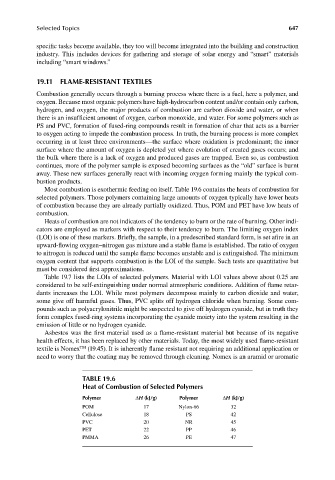Page 684 - Carrahers_Polymer_Chemistry,_Eighth_Edition
P. 684
Selected Topics 647
specific tasks become available, they too will become integrated into the building and construction
industry. This includes devices for gathering and storage of solar energy and “smart” materials
including “smart windows.”
19.11 FLAME-RESISTANT TEXTILES
Combustion generally occurs through a burning process where there is a fuel, here a polymer, and
oxygen. Because most organic polymers have high-hydrocarbon content and/or contain only carbon,
hydrogen, and oxygen, the major products of combustion are carbon dioxide and water, or when
there is an insufficient amount of oxygen, carbon monoxide, and water. For some polymers such as
PS and PVC, formation of fused-ring compounds result in formation of char that acts as a barrier
to oxygen acting to impede the combustion process. In truth, the burning process is more complex
occurring in at least three environments—the surface where oxidation is predominant; the inner
surface where the amount of oxygen is depleted yet where evolution of created gases occurs; and
the bulk where there is a lack of oxygen and produced gases are trapped. Even so, as combustion
continues, more of the polymer sample is exposed becoming surfaces as the “old” surface is burnt
away. These new surfaces generally react with incoming oxygen forming mainly the typical com-
bustion products.
Most combustion is exothermic feeding on itself. Table 19.6 contains the heats of combustion for
selected polymers. Those polymers containing large amounts of oxygen typically have lower heats
of combustion because they are already partially oxidized. Thus, POM and PET have low heats of
combustion.
Heats of combustion are not indicators of the tendency to burn or the rate of burning. Other indi-
cators are employed as markers with respect to their tendency to burn. The limiting oxygen index
(LOI) is one of these markers. Briefly, the sample, in a predescribed standard form, is set afire in an
upward-flowing oxygen–nitrogen gas mixture and a stable flame is established. The ratio of oxygen
to nitrogen is reduced until the sample flame becomes unstable and is extinguished. The minimum
oxygen content that supports combustion is the LOI of the sample. Such tests are quantitative but
must be considered fi rst approximations.
Table 19.7 lists the LOIs of selected polymers. Material with LOI values above about 0.25 are
considered to be self-extinguishing under normal atmospheric conditions. Addition of fl ame retar-
dants increases the LOI. While most polymers decompose mainly to carbon dioxide and water,
some give off harmful gases. Thus, PVC splits off hydrogen chloride when burning. Some com-
pounds such as polyacrylonitrile might be suspected to give off hydrogen cyanide, but in truth they
form complex fused-ring systems incorporating the cyanide moiety into the system resulting in the
emission of little or no hydrogen cyanide.
Asbestos was the first material used as a flame-resistant material but because of its negative
health effects, it has been replaced by other materials. Today, the most widely used fl ame-resistant
TM
textile is Nomex (19.45). It is inherently flame resistant not requiring an additional application or
need to worry that the coating may be removed through cleaning. Nomex is an aramid or aromatic
TABLE 19.6
Heat of Combustion of Selected Polymers
Polymer ∆H (kJ/g) Polymer ∆H (kJ/g)
POM 17 Nylon-66 32
Cellulose 18 PS 42
PVC 20 NR 45
PET 22 PP 46
PMMA 26 PE 47
9/14/2010 3:44:05 PM
K10478.indb 647 9/14/2010 3:44:05 PM
K10478.indb 647

